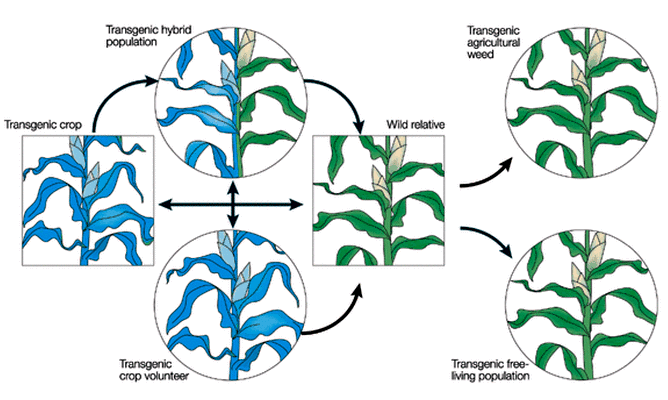Gene flow represents a recurrent exchange of genes between populations. This exchange results when immigrants from one population interbreed with members of another.
Charles Darwin published On the Origin of Species by Means of Natural Selection in 1859. Since then, scientists have modified and added new concepts to the theory of evolution by natural selection. One of those concepts, which was only dimly understood in Darwin’s lifetime, is the importance of genetics in evolution, especially the concepts of migration and gene flow.
Genes
Genes are elements within the cells of a living organism that control the transmission of hereditary characteristics by specifying the structure of a particular protein or by controlling the function of other genetic material. Within any species, the exchange of genes via reproduction is constant among its members, ensuring genetic similarity.
  |
If a new gene or combination of genes appears in the population, it is rapidly dispersed among all members of the population through inbreeding. New alleles (forms of a gene) may be introduced into the gene pool of a breeding population (thus contributing to the evolution of that species) in two ways: mutation and migration. Gene flow is integral to both processes.
A mutation occurs when the DNA code of a gene becomes modified so that the product of the gene will also be changed. Mutations occur constantly in every generation of every species.
Most of them, however, are either minor or detrimental to the survival of the individual and thus are of little consequence. Avery few mutations may prove valuable to the survival of a species and are spread to all of its members by migration and gene flow.
Separation and Migration
In nature, gene flow occurs on a more or less regular basis between demes, geographically isolated populations, races, and even closely related species. Gene flow is more common among the adjacent demes of one species.
The amount of migration between such demes is high, thus ensuring that their gene pools will be similar. This sort of gene flow contributes little to the evolutionary process, as it does little to alter gene frequencies or to contribute to variation within the species.
Much more significant for the evolutionary process is gene flow between two populations of a species that have not interbred for a prolonged period of time.
   |
Populations of a species separated by geographical barriers (as a result, for example, of seed dispersal to a distant locale) often develop very dissimilar gene combinations through the process of natural selection. In isolated populations, dissimilar alleles become fixed or are present in much different frequencies.
When circumstances do permit gene flow to occur between populations, it results in the breakdown of gene complexes and the alteration of allele frequencies, thereby reducing genetic differences in both. The degree of this homogenization process depends on the continuation of interbreeding among members of the two populations over extended periods of time.
Hybridization
The migration of a few individuals from one breeding population to another may, in some instances, also be a significant source of genetic variation in the host population. Such migration becomes more important in the evolutionary process in direct proportion to the differences in gene frequencies—for example, the differences between distinct species.
Biologists call interbreeding between members of separate species hybridization. Hybridization usually does not lead to gene exchange or gene flow, because hybrids are not often well adapted for survival and because most are sterile.
 |
| Hybridization of Bluebells |
Nevertheless, hybrids are occasionally able to breed (and produce fertile offspring) with members of one or sometimes both the parent species, resulting in the exchange of a few genes or blocks of genes between two distinct species.
Biologists refer to this process as introgressive hybridization. Usually, few genes are exchanged between species in this process, and it might be more properly referred to as “gene trickle” rather than gene flow.
Introgressive hybridization may, however, add new genes and new gene combinations, or even whole chromosomes, to the genetic architecture of some species. It may thus play a role in the evolutionary process, especially in plants.
Introgression requires the production of hybrids, a rare occurrence among highly differentiated animal species but quite common among closely related plant species. Areas where hybridization takes place are known as contact zones or hybrid zones. These zones exist where populations overlap.
In some cases of hybridization, the line between what constitutes different species and what constitutes different populations of the same species becomes difficult to draw. The significance of introgression and hybrid zones in the evolutionary process remains an area of some contention among life scientists.
Speciation
Biologists often explain, at least in part, the poorly understood phenomenon of speciation through migration and gene flow—or rather, by a lack thereof. If some members of a species become geographically isolated from the rest of the species, migration and gene flow cease.
Such geographic isolation can occur, for example, when populations are separated by water (as occurs on different islands or other landmasses) or valleys (different hillsides). The isolated population will not share in any mutations, favorable or unfavorable, nor will any mutations that occur among its own members be transmitted to the general population of the species.
Over long periods of time, this genetic isolation will result in the isolated population becoming so genetically different from the parent species that its members can no longer produce fertile progeny should one of them breed with a member of the parent population.
The isolated members will have become a new species, and the differences between them and the parent species will continue to grow as time passes. Scientists, beginning with Darwin, have demonstrated that this sort of speciation has occurred on the various islands of the world’s oceans and seas.

